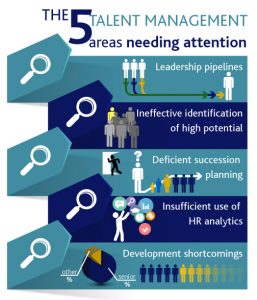Cracking Talent Management
For 15 years, the debate has raged about the ‘War for Talent’ and yet, even after so long and despite the proliferation of talent processes, talent practitioners still accept that they haven’t cracked the ‘talent nut’. In a report by Deloitte1, only 10% of companies felt their talent programmes were performing at an ‘excellent’ level.
The business case for strategically tackling talent is still a compelling one – organisations with a talent strategy are 4.2 times more likely to be in the top quartile of business outcomes2. Despite this, fewer than half of UK companies (44%) actually have a talent management strategy in place3.
 With the mass of information out there about best practice approaches, one would be forgiven for being confused about where to focus effort and resource. We reviewed a range of strategic talent management reports and in this article identify the pertinent issues to show what would add value to talent programmes. We asked Alison Rose, a seasoned practitioner of 15 years in the talent space, to identify the key areas of focus.
With the mass of information out there about best practice approaches, one would be forgiven for being confused about where to focus effort and resource. We reviewed a range of strategic talent management reports and in this article identify the pertinent issues to show what would add value to talent programmes. We asked Alison Rose, a seasoned practitioner of 15 years in the talent space, to identify the key areas of focus.
Leadership pipelines
The quality of leadership and lack of a healthy leadership pipeline is consistently cited as the key challenge for UK companies (86%)1, made even more critical by a lack of preparation for the departure of senior leaders – 59% say they are not or are only a little prepared3. So, with so many believing they are not making progress in this area, what are the reasons?
- Focus is almost exclusively at the top – resource is narrowly targeted on senior executives rather than taking a broader developmental approach across all levels in the organisation. Talent is not identified and developed further down the pipeline – 62% do not include first level and mid-managers in succession plans4 and typically less than one-in-five skilled professionals are included in succession planning4.
- Talent development is not seen to be a priority – leaders are not being incentivised to develop their successors and build talent across the organisation.
- Widening the net beyond ‘High Potentials’ – investment is heavily focused on ‘high potentials’ but the lack of confidence in accurate identification of potential indicates a better balance could be struck by more inclusive approaches which also direct resource towards specialists and the wider employee population.
- Inability to develop Millennial leaders – only 6% think they have excellent development programmes to develop Millennial leaders5 – but as the largest element of the workforce, Millennials are being promoted ever faster, requiring greater development focus.
Alison says, “Leaders still don’t see the identification and development of talent as part of their leadership DNA but as an add-on they are required to do – until they do, it is extremely difficult to embed talent management.”
Ineffective identification of high potential
Accurately identifying the right individuals as high potential is an area where companies are not confident they are getting it right – just 51% feel confident in their talent decisions5. Reasons for this are:
- Confusing performance with potential – executives confuse good performance with potential, over-relying on ‘skills and competencies’5 rather than behaviours and traits as the main drivers for promotions.
- Subjective assessment of potential – factors such as learning agility, drive, self-awareness and analytical and reasoning skills are shown to be positive indicators of leadership potential. Good, objective assessment can accurately pinpoint individuals showing potential in these areas but talent management processes are still not robust enough to drive out subjectivity.
Deficient succession planning
There is insufficient effective planning for succession – only 28% of UK companies have formal succession planning in place for senior managers3, whilst companies recognise that career paths for specialists are limited.
Changing business needs and the varying personal ambitions of potential talent demand the development of wider talent pools than are traditionally drawn upon for succession planning. Introducing succession planning earlier in careers and taking account of development need and personal ambition will give a more realistic approach to matching individuals to role requirements as these change.
Alison has concerns that good talent is missed – “Revisiting potential later in a career can open avenues for successful succession. Giving people the opportunity to re-engage around careers at different lifecycle stages, for example, when children are older, can find potential which may have been missed.”
 Insufficient use of HR analytics to link HR activity to business performance
Insufficient use of HR analytics to link HR activity to business performance
HR’s role is changing from a service provider to an enabler and builder of talent to meet business objectives. The use of technology and HR data integrated with wider organisation management information is, however, lagging far behind the speed of these changing requirements.
Alison comments, “Although there is an appetite for data, this is often used to promote a compliance approach to HR practice – the real value of analytics is to give useful insight into your talent issues and to start the conversations about the people agenda.”
Development shortcomings
Development is not delivering enough ‘ready now’ talent, so the mix of external to internal hiring is out of balance – 43% of C-suite positions are filled from outside the organisation6. Commonly:
- Development is too generic and not sufficiently targeted at individual and specific business needs.
- Organisations are not investing in development at earlier career stages, meaning leadership talent pipelines are impeded.
- Millennial employees want development which is at their fingertips and provided in faster and user-friendly ways but companies are not yet embracing these new delivery channels and methods1.
This picture is changing as companies recognise the challenge to ‘grow their own’ – 43% expect to increase development expenditure, whilst over one-in-five plan to reduce spend on recruitment3.
Ten Simple Steps for Success
“Complex talent processes and categorisations such as ‘ready now, ready in one year’ can be counter-productive when, for example, there may not be available promotions”,says Alison. “A lighter touch with more emphasis on organisation-wide development will help with retention whilst giving organisations a workforce more able to flex to meet the business need.”
So, if you feel that you’re stuck in ‘Groundhog Day’, what are the steps for success? Our review revealed no silver bullet, but an emphasis on more joined up thinking and less focus on process compliance:
- Understand the business strategy and the plans to achieve this plus the anticipated challenges. Clarify what the core talent requirements are in order to address those needs and challenges.
- Use HR data to give useful insight into your talent requirements and challenges but triangulate it with wider organisational and HR management information – focus on collecting meaningful data rather than on insisting on data collection compliance.
- Use the insight from your HR data to create a talent strategy – prioritise those talent pools critical to achieving business goals, using a data-led approach. Ensure your strategy covers all the bases in terms of recruiting, developing, mobilising and retaining talent relating to those critical talent pools.
- Define what successful leadership looks like in your organisation and benchmark your talent to identify gaps in what is required. Make your assessment focus developmental rather than an in/out process, to protect not only people’s dignity, but also the reputation of your talent approach.
- Succession plan across the entire organisation, but focus on broad, flexible pools of talent at the mid and junior levels, rather than the slate-based approach you would take for more senior roles – include specialists, early career employees, first level managers and mid-managers as well as senior leaders.
- Create recruitment and retention strategies appropriate to Millennials. [See our March 2015 article, Generation Z.]
- Be clear and transparent on what high potential and succession planning mean, and on how potential is assessed, so employees know what it takes to be promoted and what opportunities are genuinely there. Don’t overpromise – the pyramid of available roles narrows significantly at the more senior levels so not everyone will achieve promotion. Frame your talent approaches as being about satisfying work and lateral moves as well as upward progression.
- Embed a talent management focus amongst leaders by incentivising them and supporting them to have honest conversations with their employees about potential and development.
- Take a broad based approach to development by investing resource within the entire talent pipeline and not just at senior levels.
- Revisit high potential decisions regularly, giving opportunities for individuals to revisit high potential avenues at later stages in their careers.
Sources:
- Global Human Capital Trends 2015 – Leading in the New World of Work – UK Report – Deloitte
- Building Competitive Advantage with Talent – Josh Bersin
- Strategic Talent Management Survey Results 2014 – Striving for long-term success – Cranfield School of Management, Halogen Software and HRZone.com
- Effective Succession Management Planning – Part 1 of the Succession Matters series – Korn Ferry
- Accurate Identification of Leadership Potential – Part 2 of the Succession Matters series – Korn Ferry
- Impactful Leadership Development and Accelerated Readiness – Part 3 of the Succession Matters series – Korn Ferry
For more information please contact: Mike Vessey or Alison Rose

